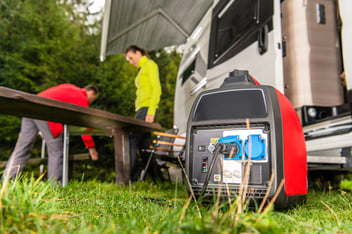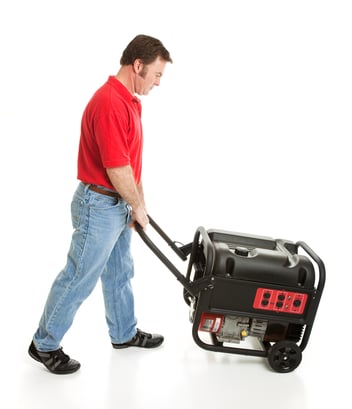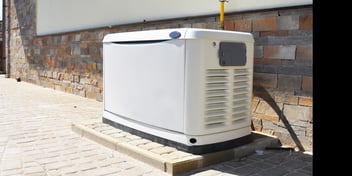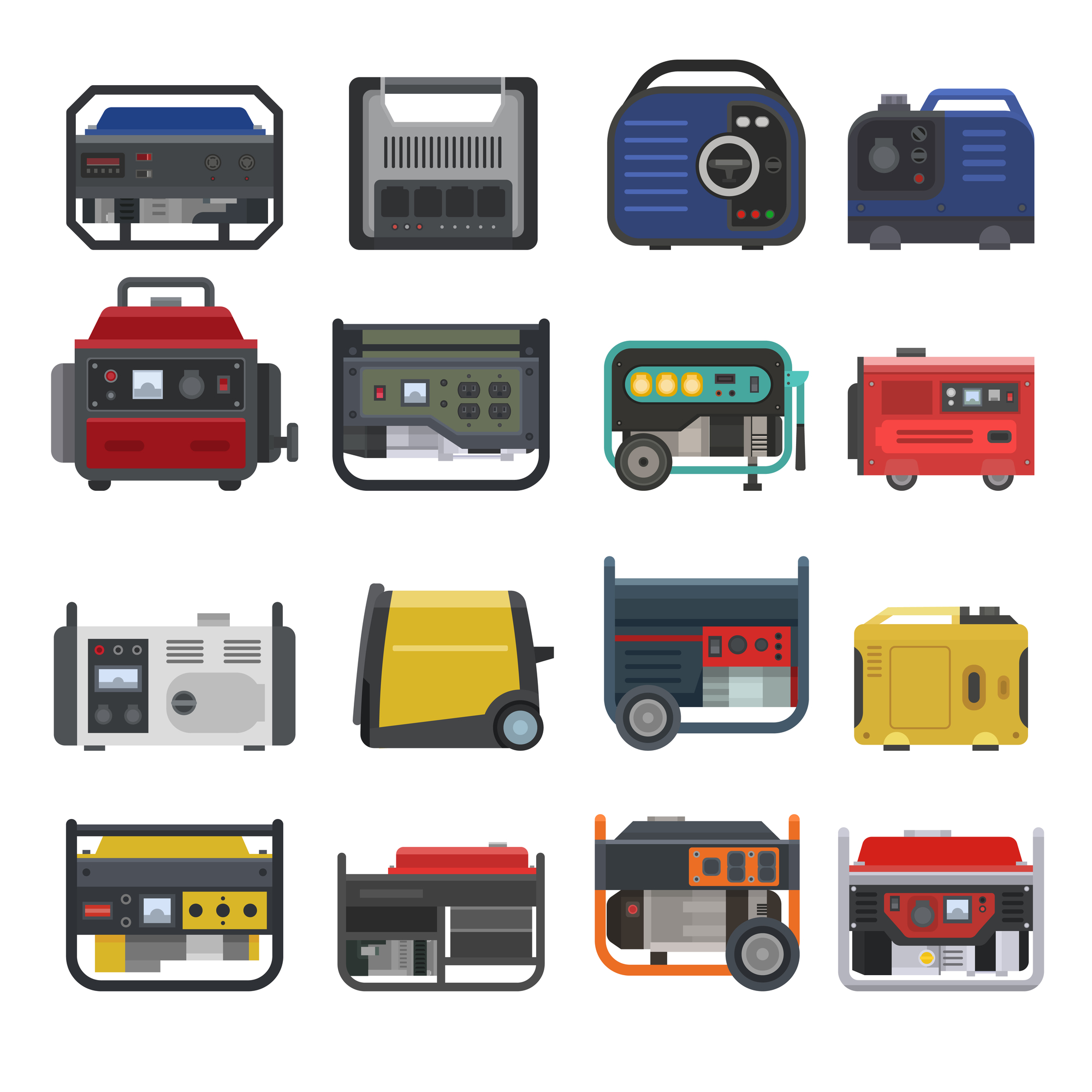The two questions of “what kind of generator do I need” and “how big of a generator do I need” are the most common areas of concern for people considering investing in power generation equipment. The good news is that there are some easy ways to figure out the answers to both questions. Learn about the differences in types of consumer generators and which is best for your situation.
Basic generator terms
Figuring out what type of generator you might need is the first step to protecting you family or bringing power with you on the go. Let’s start with a few definitions:
- Generator – generally defined as a reciprocating engine that is configured to produce alternating current (AC) electricity. The generator makesthis electricity through either the generator end (barrel) or an alternator (and inverter). Generators run on a variety of fuel sources, including gasoline, diesel, natural gas, and propane.
- Portable generator – Portable generators are designed to be moved. These generators are generally the smallest in terms of capacity, size, and weight. Portable generators come in a few different types, including frame generators, wheeled generators, and liftable generators. Portable generators generally run off gasoline or propane, while some larger ones use diesel.
- Home standby generator (HSB) – HSB generators are intended to provide emergency power during a grid outage or blackout. These generators are repentantly installed outside of a home and automatically start when the ATS senses an outage. They are generally larger in capacity than portable generators and run off propane, natural gas, or diesel. Most home standby generators run at 3600 RPM. Home standby generators are generally rated for standby purposes.
- Commercial / industrial generator – Large loads require larger generators. Generator Mart doesn’t carry large diesel generators, so if you have an application above 100 kW – head over to Generator Source for commercial diesel and natural gas generators (up to 4 MW). Commercial and industrial generators run at 1800 RPM and can be standby, prime, or continuous rated.
- RV generator – RV generators are designed specifically to be installed in a recreational vehicle or travel trailer. They are also sometimes called cabinet generators. These small generators run the essential services on an RV (like air conditioning) and charge the deep cycle batteries.
- Towable generator – Towable generators are larger portable generators that require a truck to transport to a use location. They generally start at 20 kW and grow to 18-wheeler sized 2MW generators. Generator Source carries a wide variety of towable generators.
- Automatic transfer switch (ATS) – ATS’s help automatically get a building onto generator power in the event of a blackout. The ATS senses a grid outage, switches the building’s power source from grid to generator, and queues the generator to start up. They are very important because they allow the generator to start without having to manually start it and also prevent power from back feeding onto the utility grid.
- Kilowatt (kW) – A kilowatt is a measure of of electrical power. It’s used to express how much power a generator can provide at any given time. 1 kilowatt equals 1,000 watts, so a 4.5 kW generator can provide 4,500 watts of power. Generators are measured in their peak and continuous kW ratings. Kilowatts are also a way to understand how much power a home might need during an outage.
What type of generator do I need?
Now that we have a common language to use, let’s understand some of the considerations on how to select the right type of generator. Deciding between portable and home stand by generators is generally a fairly easy decision. Portable generators can be used for recreational activities, while camping, and at construction job sites. Home standby generators serve a very specific purpose – to power your home during an electrical outage. Portable generators can be used during outages – find out more in a separate article we wrote.
Portable Generators: the most important consideration for portable gasoline generators (outside of the capacity) is the ability to move the generator. This generally dictates exactly what type of generator to purchase. Other considerations include:
- Fuel type – Most portable generators run off gasoline (petrol) but there are units such at the Cummins Onan P9500df, which can run on gas or propane.
- Size / weight – Portability is the name of the game with portable generators. Larger capacity also increases size and weight. Super small units, such as the Cummins P2500i, can be easily moved by a single person, while larger portables may require two people to move. Larger generators often feature wheels to ease transportation.
- Sound – People that use generators while camping (either tent camping or RVing) want a quiet generator to minimize their disturbance on others. Inverter generators are able to scale their power to the electrical draw, decreasing the sound (DB) during low use.
- Power stability – Some electrical appliances (such as computers) need very stable electricity to operate properly. This can be accomplished using an inverter generator, which produces less harmonic disturbance.
- Plug types – Extension cords are used to move electricity from the generator to where it will be used. Travel trailer (TT) type plugs and cords can move more energy than standard blade type extension cords. Some generators feature multiple plug types, as well as USB plugs.
- Remote start – An increasingly popular feature, remote start capabilities allow the portable generator to be started from a distance away. Some portable generators include a wireless remote start with a key-fob type starter. Others utilize a wired connection and can be integrated with an ATS. Our most popular remote start portable generator is the Onan P4500i.
Home Standby Generators: size and fuel type are generally the most important factors for home standby generators. You’ll need to work with an electrician to install the generator at your home or business. Important considerations include:
- Fuel type – Most home standby generators run off natural gas (with option to convert to propane). It is important to determine if you have a utility NG connection to power the generator. In more remote locations, diesel is the best option to power your generator.
- Cold weather capability – In climates where temperatures routinely stay below 32°F (0°C), additional heating elements are added to ensure the capability of the generator. Most manufacturers offer out of the box cold weather models or as aftermarket upgrade kits.
- Atheistics – Generators generally aren’t the center piece to a home’s landscaping, so they are designed to blend into the environment. Most come in a gray or tan enclosure to be easily overlooked when installed.
- Hurricane rating – If you live in a hurricane prone area, it’s best to purchase a generator that has a high wind rating. Units like the Kohler 24RCL are specifically tested to survive hurricane force winds (up to 181 MPH).
- ATS – You will need an automatic transfer switch (ATS) to automatically start your generator in the event of an outage. ATSs are sized by their number of amps, similarly to how the circuit breaker panel on your home is sized. 100 and 200 amp ATS are most common in 208V single phase residential applications. An amperage chart can be used to concert kilowatts and voltage to amps.
- Intended usage – It is important to consider how the generator will be used when selecting an appropriate unit. A few key considerations include number of hours to be run a year (1,800 RPM engines are better for increased usage) and the need to start electric motors with large in-rush currents (such as winches).
How big of a generator do I need?
Home standby generators are sized based on the amount of power (measured in kW) required for use during an outage. The most conservative approach to sizing targets the home’s peak electrical demand and picks a generator capable of handling that load. It is very important to get the generator size right because generators increase in cost with size and running a large generator with a minimal (<40% of stated) load for long periods of time can negatively impact performance. More details are available in this article on sizing.
The most important decision in sizing a generator is around the desire to power your entire home or just a minimal amount of appliances. There are two competing schools of thought in this area:
- Power the whole home – This is the “business as usual” approach, where the homeowner desires for their lifestyle to be minimally impacted by a grid outage. Powering the entire home will require a larger generator but this will allow the homeowner to use any/all appliances during an outage.
- Power only essentials – This is the more cost conscious approach to home standby power, where the homeowner consciously decides that only certain capabilities are important / essential during an outage. This might be powering the A/C, sump pump, refrigerator, and limited interior lighting. Attempting to pull more load than the generator and ATS are capable of may trip the breaker or cause the generator to shut down. Using an essentials only approach requires a smaller generator and will likely cost less.
There are a number of methods that homeowners can use to determine the size of generator that they want to purchase. Utilizing multiple methods can help triangulate on a size that will provide the capacity needed without overpaying for too large of a generator.
- Square footage calculation – The simplest method for calculating power requirements is to use a basic per square footage factor. Most sources use 0.5 kW per square foot, so a 2,000 sqf home would require 10 kW. This factor can rise to 1.0 kW per sqf in warm climates where the home depends on air conditioning regularly.
- Online calculator – Our site features a calculator that can be used to estimate electrical draw of common home appliances and systems. This allows a quick calculation to get a ballpark range of generator size required for those appliances.
- Electric bill – Looking back at 2 years of electric bill history, homeowners can look for their peak demand (the highest draw at any single moment) for the maximum amount of power their home has used. Some bills may not feature this statistic and it’s important to note that the history only includes how the home was configured not any new additions or appliances (e.g., a hot tub).
- Use breaker size – Using your circuit breaker’s capacity can tell you the maximum generator size that your home could handle (based on it’s current configuration). Circuit breakers panels typically come in 100 or 200 amp units, though other sizes are also common. Once you have the total breaker capacity (and type of voltage – 208V is most common in the US), use an amperage chart to back into the size of generator required to power all circuits simultaneously. Note that this method will provide the largest generator size and additional analysis should be conducted to ensure that you do not grossly oversize the generator.
- Add up appliance draw – The most exact self-performed calculation is to walk through your home and add all of the nameplate capacities of your home appliances. When the nameplate is not readable or accessible, performing an internet search to determine it’s electrical draw (in watts) can be helpful.
- Call an electrician – The most sure method is to call a qualified electrician to help you size your electrical requirements. Local electricians will be experts on your regional requirements as well as any code or other municipal issues your home may be subject to. Like all contractors, be prepared to pay for their expertise.
Ratings Definitions:
Emergency Standby Power (ESP): Applicable for supplying power to varying electrical load for the duration of power interruption of a reliable utility source. Emergency Standby Power (ESP) is in accordance with ISO 8528. Fuel Stop power in accordance with ISO 3046, AS 2789, DIN 6271 and BS 5514.
Limited-Time Running Power (LTP): Applicable for supplying power to a constant electrical load for limited hours. Limited-Time Running Power (LTP) is in accordance with ISO 8528.
Prime Power (PRP): Applicable for supplying power to varying electrical load for unlimited hours. Prime Power (PRP) is in accordance with ISO 8528. Ten percent overload capability is available in accordance with ISO 3046, AS 2789, DIN 6271 and BS 5514.
Base Load (Continuous) Power (COP): Applicable for supplying power continuously to a constant electrical load for unlimited hours. Continuous Power (COP) in accordance with ISO 8528, ISO 3046, AS 2789, DIN6271 and BS 5514.
RELATED POSTS
Proin auctor nibh vitae urna lobortis, in vulputate erat facilisis. Sed lacinia lorem eget orci finibus, et maximus nisi sagittis.

How to Select the Best Portable Generator for Your RV
RV and camping season is just around the corner. Outdoor adventure’s with friends and family brings a need to have reliable power in the form of a...
Read more »
Introduction to portable inverter generators
What is an inverter generator?
An inverter generator is different from a conventional generator because it uses an inverter (hence the name) to turn...
Read more »
How to Choose the Right Generator
In an ideal world, there wouldn’t be natural disasters that cause wide-spread power outages, property damage, and loss of life. But the unfortunate...
Read more »
